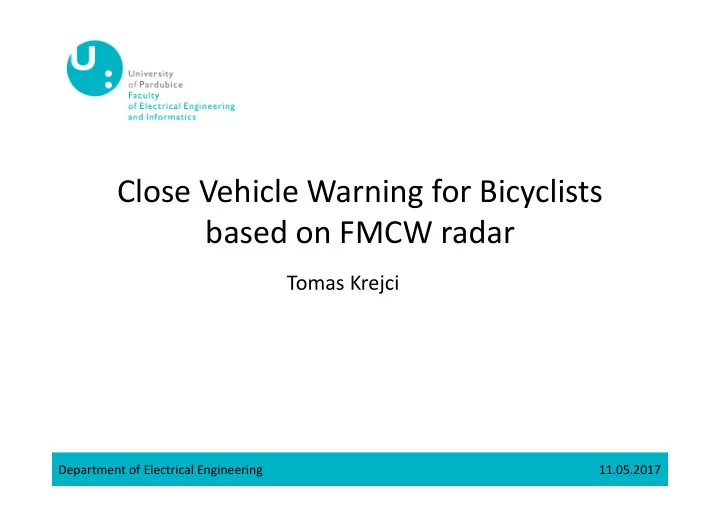

Close Vehicle Warning for Bicyclists based on FMCW radar Tomas Krejci Department of Electrical Engineering 11.05.2017
INTRODUCTION • Concept of the close vehicle warning systém. • System based on Frequency Modulated Continuous Wave (FMCW) radar sensor. The radar works at frequency of 24.1 GHz with 180 MHz bandwidth. • The implementation of the signal processing is realized in a Field Programmable Gate Array System On Chip Department of Electrical Engineering 11.05.2017 1
FMCW • FMCW radar is able to measure distances of static objects using Frequency shift of transmission and reception signal • The maximum ambiguous range is at 47.96 m • The resolution in the range is 0.373 m • The maximum ambiguous velocity is 12.19 m/s • The minimum detectable step in velocity is 0.381 m/s Department of Electrical Engineering 11.05.2017 2
PROTOTYPE • The prototype of radar system is built an Altera kit with Cyclone V System On Chip (SoC, in this case FPGA + ARM in one integrated circuit), and data convert card with two ADCs and two DACs. • A radar sensor K-LC1a. The radar works at 24.125 GHz with bandwidth 180 MHz. Department of Electrical Engineering 11.05.2017 3
REAL MEASUREMENT • Prototype testing was performed in the university courtyard • Three peaks were detected using adaptive threshold and these peaks relate to the targets in the • The vehicle velocity was 15 km/h (4.16 m/s) and the distance of the vehicle was 4.5 m (red bordered object). • The static objects around the vehicle were detected, and these are marked in the green box. A faintly detectable object (penthouse) is marked in yellow. Department of Electrical Engineering 11.05.2017 4
ACKNOWLEDGEMENT & CONTACT Tomáš Krejčí Tomas.Krejci2@student.upce.cz Department of Electrical Engineering Faculty of Electrical Engineering and Informatics University of Pardubice Czech Republic http://www.upce.cz/en/fei/ke.html The described research was supported by the Internal Grant Agency of University of Pardubice, the project No. SGSFEI_ 2017_026 Department of Electrical Engineering 11.05.2017 5
Recommend
More recommend